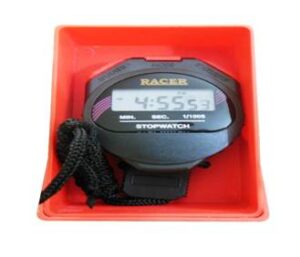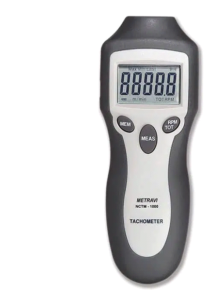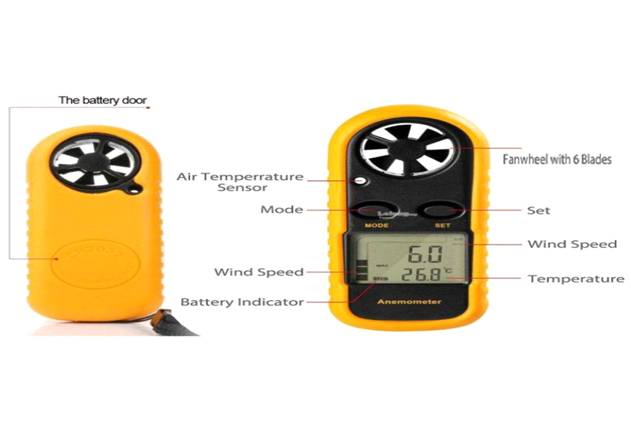IR Thermometer/Infrared Thermometer
 An infrared thermometer is a thermometer which infers temperature from a portion of the thermal radiation sometimes called black-body radiation emitted by the object being measured. They are sometimes called laser thermometers as a laser is used to help aim the thermometer, or non-contact thermometers or temperature guns, to describe the device’s ability to measure temperature from a distance. By knowing the amount of infrared energy emitted by the object and its emissivity, the object’s temperature can often be determined within a certain range of its actual temperature. Infrared thermometers are a subset of devices known as “thermal radiation thermometers”.
An infrared thermometer is a thermometer which infers temperature from a portion of the thermal radiation sometimes called black-body radiation emitted by the object being measured. They are sometimes called laser thermometers as a laser is used to help aim the thermometer, or non-contact thermometers or temperature guns, to describe the device’s ability to measure temperature from a distance. By knowing the amount of infrared energy emitted by the object and its emissivity, the object’s temperature can often be determined within a certain range of its actual temperature. Infrared thermometers are a subset of devices known as “thermal radiation thermometers”.
Sometimes, especially near ambient temperatures, readings may be subject to error due to the reflection of radiation from a hotter body—even the person holding the instrument[citation needed] — rather than radiated by the object being measured, and to an incorrectly assumed emissivity.
The design essentially consists of a lens to focus the infrared thermal radiation on to a detector, which converts the radiant power to an electrical signal that can be displayed in units of temperature after being compensated for ambient temperature. This permits temperature measurement from a distance without contact with the object to be measured. A non-contact infrared thermometer is useful for measuring temperature under circumstances where thermocouples or other probe-type sensors cannot be used or do not produce accurate data for a variety of reasons.
Clinical Thermometer’s

A medical thermometer (also called clinical thermometer) is used for measuring human or animal body temperature. The tip of the thermometer is inserted into the mouth under the tongue (oral or sub-lingual temperature), under the armpit (axillary temperature), into the rectum via the anus (rectal temperature), into the ear (tympanic temperature), or on the forehead (temporal temperature).
Stopwatch’s
 A stopwatch is a timepiece designed to measure the amount of time that elapses between its activation and deactivation.A large digital version of a stopwatch designed for viewing at a distance, as in a sports stadium, is called a stop clock. In manual timing, the clock is started and stopped by a person pressing a button. In fully automatic time, both starting and stopping are triggered automatically, by sensors. The timing functions are traditionally controlled by two buttons on the case. Pressing the top button starts the timer running, and pressing the button a second time stops it, leaving the elapsed time displayed. A press of the second button then resets the stopwatch to zero. The second button is also used to record split times or lap times. When the split time button is pressed while the watch is running it allows the elapsed time to that point to be read, but the watch mechanism continues running to record total elapsed time. Pressing the split button a second time allows the watch to resume display of total time.
A stopwatch is a timepiece designed to measure the amount of time that elapses between its activation and deactivation.A large digital version of a stopwatch designed for viewing at a distance, as in a sports stadium, is called a stop clock. In manual timing, the clock is started and stopped by a person pressing a button. In fully automatic time, both starting and stopping are triggered automatically, by sensors. The timing functions are traditionally controlled by two buttons on the case. Pressing the top button starts the timer running, and pressing the button a second time stops it, leaving the elapsed time displayed. A press of the second button then resets the stopwatch to zero. The second button is also used to record split times or lap times. When the split time button is pressed while the watch is running it allows the elapsed time to that point to be read, but the watch mechanism continues running to record total elapsed time. Pressing the split button a second time allows the watch to resume display of total time.
Mechanical stopwatches are powered by a mainspring, which must be wound up by turning the knurled knob at the top of the stopwatch.
Digital electronic stopwatches are available which, due to their crystal oscillator timing element, are much more accurate than mechanical timepieces. Because they contain a microchip, they often include date and time-of-day functions as well. Some may have a connector for external sensors, allowing the stopwatch to be triggered by external events, thus measuring elapsed time far more accurately than is possible by pressing the buttons with one’s finger. Stopwatches that count by 1/100 of a second are commonly mistaken[by whom?] as counting milliseconds, rather than centiseconds
. The first digital timer used in organized sports was the Digitimer, developed by Cox Electronic Systems, Inc. of Salt Lake City Utah (1962). It utilized a Nixie-tube readout and provided a resolution of 1/1000 second. Its first use was in ski racing but was later used by the World University Games in Moscow, Russia, the U.S. NCAA, and in the Olympic trials.
The device is used when time periods must be measured precisely and with a minimum of complications. Laboratory experiments and sporting events like sprints are good examples.
The stopwatch function is also present as an additional function of many electronic devices such as wristwatches, cell phones, portable music players, and computers.
Digital Lux Meter’s
Lighting professionals use a light meter (also called an illuminance meter or lux meter) to measure the amount of light in a space/on a particular
work surface. The light meter has a sensor that measures the light falling on it and provides the user with a measurable illuminance reading.





Tachometer’s

 The tachometer is a measuring instrument that is used to measure the operating speed of an engine in revolutions per minute. It is also known as a revolution counter. The device can measure the rotational speed of the shaft or disc when the machine is in motion. It also indicates the angular speed of a rotating shaft. This instrument is usually used to estimate traffic speed and volume/flow. It is used in cars, aircraft or other vehicles. It shows the rate of rotation of engine crankshaft along with the marking that displays the safe range of rotational speed.
The tachometer is a measuring instrument that is used to measure the operating speed of an engine in revolutions per minute. It is also known as a revolution counter. The device can measure the rotational speed of the shaft or disc when the machine is in motion. It also indicates the angular speed of a rotating shaft. This instrument is usually used to estimate traffic speed and volume/flow. It is used in cars, aircraft or other vehicles. It shows the rate of rotation of engine crankshaft along with the marking that displays the safe range of rotational speed.
Digital Aneometer’s
Digital Anemometer allows measuring atmospheric effects, namely wind velocity, temperature, and humidity for better data analysis. It also possesses various features such as Beaufort scale, switch between Celsius and Fahrenheit, switch between metric and imperial system, or the battery status indicator.


